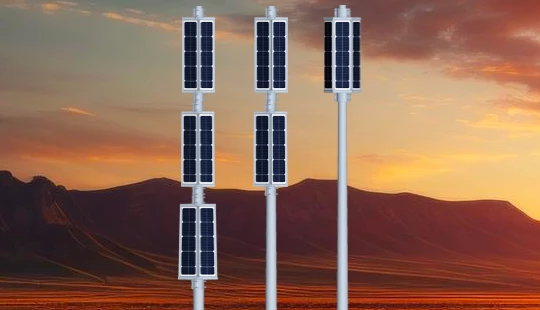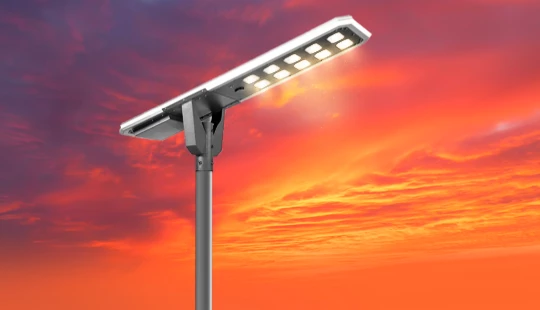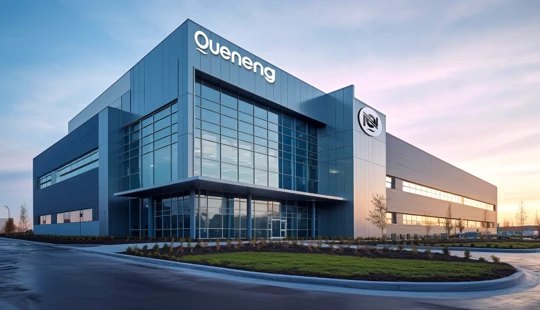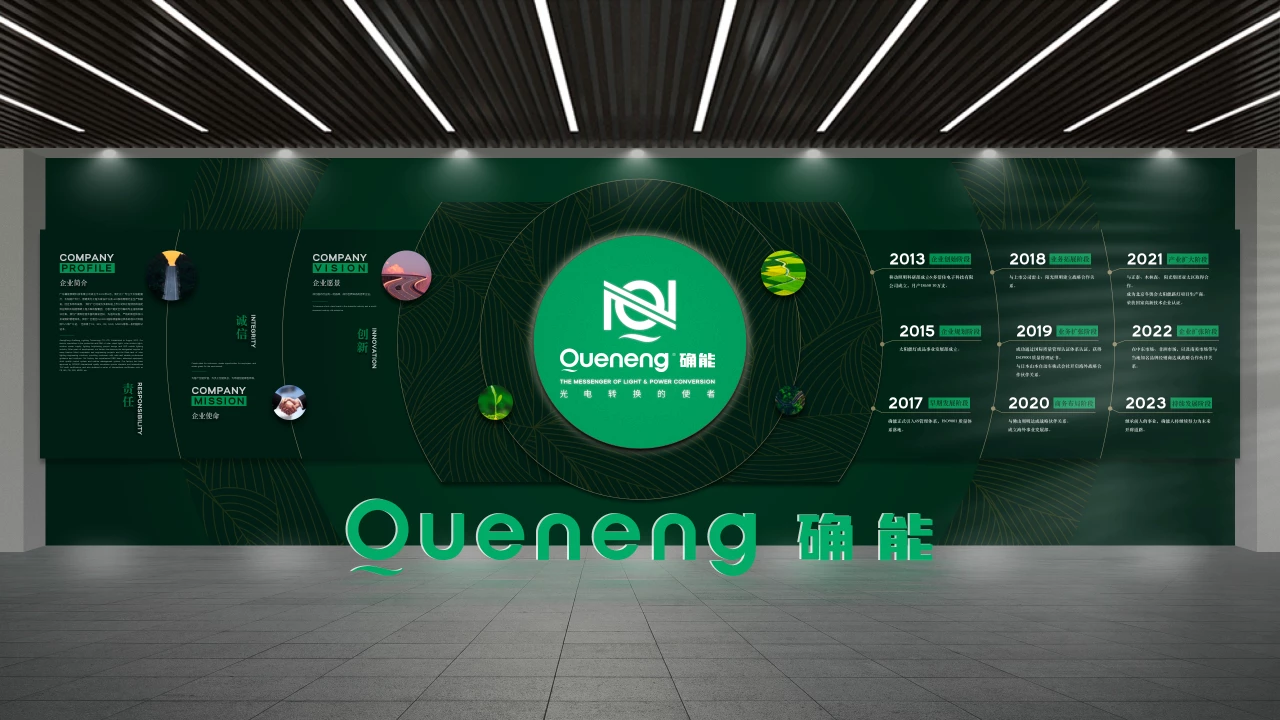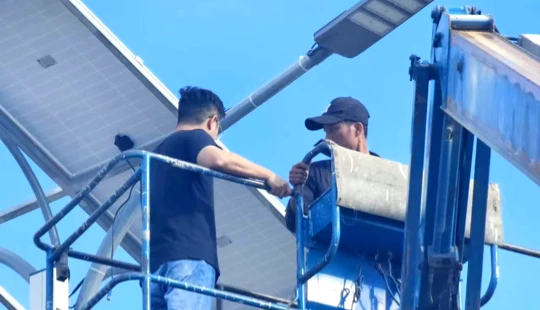OEM solar lighting for smart cities | Insights by Quenenglighting
<h2>What Makes OEM Solar Lighting Essential for Smart City Infrastructure?</h2><p>As urban centers worldwide strive for greater sustainability, efficiency, and connectivity, the role of intelligent infrastructure becomes paramount. OEM (Original Equipment Manufacturer) solar lighting stands out as a critical component in this evolution. Unlike traditional grid-powered lights, OEM solar lighting systems offer energy independence, significantly reducing reliance on conventional power grids and mitigating electricity costs. This self-sufficiency is vital for enhancing grid resilience and ensuring continuous illumination even during power outages.</p><p>The integration of solar lighting into smart cities aligns perfectly with global sustainability goals. According to various market research reports, the global smart lighting market, which includes solar solutions, was valued at approximately USD 13.9 billion in 2023 and is projected to reach over USD 100 billion by 2030, demonstrating a Compound Annual Growth Rate (CAGR) of around 24%. This growth underscores the increasing demand for eco-friendly and intelligent lighting solutions that contribute to a reduced carbon footprint, healthier urban environments, and improved air quality by lessening the demand for fossil fuel-generated electricity.</p><p>Furthermore, OEM solar lighting facilitates rapid deployment and scalability. Without the need for extensive trenching and cabling, installation times and costs are drastically cut, making it an ideal solution for remote areas, new developments, or quick upgrades to existing infrastructure. This ease of deployment, coupled with inherent safety benefits from lower voltage systems and elimination of power line hazards, positions OEM solar lighting as an indispensable element in the smart city blueprint.</p><h3>How Do OEM Solar Lighting Solutions Integrate with Smart City IoT Platforms?</h3><p>The 'smart' in smart cities is powered by interconnected devices and data, and OEM solar lighting systems are at the forefront of this integration. Modern solar streetlights are no longer just light sources; they are intelligent nodes within a broader Internet of Things (IoT) network. Through advanced communication protocols like LoRaWAN, NB-IoT, and even 5G, these lights can seamlessly communicate with central management platforms.</p><p>This integration enables a multitude of smart features:</p><ul> <li><strong>Remote Monitoring and Control:</strong> City managers can remotely dim or brighten lights, set schedules, and monitor system performance (e.g., battery charge, solar panel efficiency) from a centralized dashboard, optimizing energy consumption and prolonging component life.</li> <li><strong>Predictive Maintenance:</strong> Real-time data collection allows for early detection of faults or declining performance, enabling proactive maintenance rather than reactive repairs, significantly reducing operational downtime and costs.</li> <li><strong>Adaptive Lighting:</strong> Equipped with motion sensors, lights can automatically adjust brightness based on pedestrian or vehicular traffic, saving energy during low-activity periods. This feature alone can lead to energy savings of 20-40% compared to traditional fixed-output lighting.</li> <li><strong>Multi-Sensor Integration:</strong> Beyond lighting, OEM solar poles can host various sensors for air quality monitoring (PM2.5, CO2), noise detection, traffic management, public Wi-Fi hotspots, and even integrated CCTV cameras, transforming them into multi-functional smart city hubs.</li> <li><strong>Data Analytics:</strong> The aggregated data provides invaluable insights into urban patterns, resource utilization, and environmental conditions, aiding city planners in making data-driven decisions for future development.</li></ul><h3>What are the Key Performance and Durability Standards for Smart City Solar Lights?</h3><p>For smart city applications, the performance and durability of OEM solar lighting are non-negotiable. Procurement professionals must scrutinize several key standards:</p><ul> <li><strong>High-Efficiency Solar Panels:</strong> Monocrystalline silicon solar panels are preferred for their higher efficiency rates, typically ranging from 20-23%, ensuring maximum energy harvest even in challenging weather conditions or limited space.</li> <li><strong>Advanced Battery Technology:</strong> Lithium Iron Phosphate (LiFePO4) batteries are the industry standard due to their long cycle life (typically 2,000 to 6,000 cycles), superior thermal stability, and enhanced safety compared to traditional lead-acid or even other lithium-ion chemistries. A well-designed system will offer 3-5 days of autonomy, ensuring reliable operation during extended cloudy periods.</li> <li><strong>High-Lumen Output LEDs:</strong> Modern LED chipsets offer exceptional luminous efficacy, commonly reaching 150-200 lumens per watt. This ensures bright, uniform illumination with minimal energy consumption. The lifespan of quality LEDs can exceed 50,000-100,000 hours, equivalent to over 10-20 years of typical night-time operation.</li> <li><strong>Robust Enclosure and Ingress Protection (IP) Rating:</strong> For outdoor installations, an IP65 or IP66 rating is essential, guaranteeing protection against dust ingress and powerful water jets, vital for resisting harsh environmental conditions like heavy rain, strong winds, and dust storms.</li> <li><strong>Temperature Tolerance:</strong> Components must be designed to operate reliably across a wide temperature range, typically from -20°C to +60°C, to suit diverse climatic zones.</li> <li><strong>Corrosion Resistance:</strong> High-grade aluminum alloys or galvanized steel with specialized coatings are necessary for poles and fixtures to withstand corrosion, especially in coastal or industrial areas.</li></ul><p>Adhering to these standards ensures a reliable, long-lasting, and high-performing solar lighting system, minimizing maintenance needs and maximizing return on investment.</p><h3>What is the ROI and Cost-Effectiveness of Deploying OEM Solar Lighting in Urban Environments?</h3><p>While the initial investment in OEM solar lighting might appear higher than conventional grid-tied solutions, the long-term Return on Investment (ROI) and overall cost-effectiveness are compelling for smart cities.</p><ul> <li><strong>Zero Electricity Bills:</strong> The most significant saving comes from eliminating electricity consumption from the grid. Over the lifespan of the system (20+ years for solar panels), these savings accumulate substantially, making the payback period for a well-designed solar street light typically 3 to 7 years, depending on local electricity rates and installation costs.</li> <li><strong>Reduced Installation Costs:</strong> The absence of trenching, cabling, and complex grid connections dramatically cuts down installation time, labor, and material costs. This is particularly beneficial for large-scale deployments or areas with challenging terrain.</li> <li><strong>Lower Maintenance Costs:</strong> With remote monitoring capabilities and durable components, smart solar lights require significantly less physical inspection and maintenance. Remote diagnostics can reduce on-site visits by up to 70-80%, leading to considerable operational savings over the system's lifetime.</li> <li><strong>Environmental and Social Benefits:</strong> Though harder to quantify in direct financial terms, the environmental benefits (reduced carbon emissions, improved air quality) and social benefits (enhanced public safety, extended economic activity during evening hours) contribute to a city's overall attractiveness and well-being, indirectly boosting economic growth and property values.</li> <li><strong>Eligibility for Incentives:</strong> Many governments and organizations offer incentives, grants, and tax credits for renewable energy projects, further enhancing the financial viability of solar lighting deployments.</li></ul><p>Considering the full lifecycle costs, OEM solar lighting provides a superior economic argument for sustainable urban development.</p><h3>How Can OEM Customization Meet the Unique Demands of Diverse Smart City Projects?</h3><p>Smart cities are not monolithic; each has unique topographical, climatic, aesthetic, and functional requirements. This is where the strength of OEM customization truly shines. An OEM partner like Quenenglighting can tailor solar lighting solutions to perfectly fit the specific demands of any project, ensuring optimal performance and seamless integration.</p><p>Key areas of OEM customization include:</p><ul> <li><strong>Lighting Design and Optics:</strong> Custom lumen output, light distribution patterns (e.g., Type II, Type III, Type IV for roadways, pathways, or parking lots), and color temperatures (e.g., 3000K warm white for residential, 5000K cool white for commercial) can be specified to meet exact lighting standards and aesthetic preferences.</li> <li><strong>Component Sizing:</strong> Battery capacity, solar panel wattage, and pole height can be precisely calculated based on geographical location (solar insolation), required autonomy days, and desired illumination levels, ensuring year-round reliability.</li> <li><strong>Aesthetic Integration:</strong> Designs can be adapted to match urban architecture, historical districts, or specific landscape themes, using custom pole designs, colors, and fixture styles.</li> <li><strong>Integrated Features:</strong> Beyond basic lighting, OEM solutions can incorporate specific smart city features such as public address systems, digital signage, EV charging points, panic buttons, or integrated cameras for security and traffic monitoring, all within a single pole structure.</li> <li><strong>Software and Connectivity:</strong> Customization extends to the back-end, allowing for specific communication protocols, data reporting formats, and integration with existing smart city platforms or data dashboards.</li> <li><strong>Scalability:</strong> OEM partners can develop modular solutions that are scalable from pilot projects with a few units to city-wide deployments of thousands of lights, ensuring consistency and efficient management.</li></ul><p>This level of bespoke engineering ensures that smart city solar lighting solutions are not just off-the-shelf products but perfectly optimized tools that contribute to a city's unique vision and strategic goals.</p><p><strong>Quenenglighting: Your Partner for Advanced OEM Solar Lighting Solutions</strong></p><p>As a leading OEM provider in the solar lighting industry, Quenenglighting offers a distinct advantage for smart city developers and procurement specialists. Our strengths lie in:</p><ul> <li><strong>Comprehensive R&D Capabilities:</strong> We continually invest in research and development to bring the latest in solar energy, LED technology, and IoT integration to our products, ensuring cutting-edge performance and reliability.</li> <li><strong>Unmatched Customization:</strong> From concept to deployment, we work closely with clients to deliver tailor-made solutions that meet specific technical requirements, aesthetic considerations, and budget constraints for diverse smart city applications.</li> <li><strong>High Quality Quality Components:</strong> We utilize only the highest-grade solar panels, long-life LiFePO4 batteries, and high-efficiency LED chipsets, guaranteeing durable and high-performing systems that provide superior ROI.</li> <li><strong>Integrated Smart Features:</strong> Our solutions are designed for seamless integration with smart city IoT platforms, offering advanced remote monitoring, control, and multi-sensor capabilities for truly intelligent urban infrastructure.</li> <li><strong>Global Project Expertise:</strong> With years of experience serving a diverse global clientele, we understand the complexities of international projects and provide expert guidance from design to after-sales support.</li></ul><p>Partner with Quenenglighting to illuminate your smart city vision with sustainable, intelligent, and custom-engineered solar lighting solutions that deliver long-term value and operational excellence.</p>
Have more questions about our products or services?
The latest hot news you might like

Discover how solar panels power street lights, exploring the technology behind solar energy conversion, storage systems, and how solar-powered street lights are revolutionizing urban and rural lighting solutions.

Learn how AC Solar Hybrid Street Lights work, their advantages, disadvantages, system behavior in low-sunlight conditions, and why hybrid technology is ideal for regions with unstable sunlight.

Municipalities around the world are increasingly adopting solar-powered streetlights as part of their urban development strategies. Rising energy costs, the need for sustainable infrastructure, and government green initiatives are driving cities to switch from traditional street lighting to advanced LED solar streetlights.
Queneng Lighting provides municipalities with cost-effective, energy-efficient, and durable solar lighting solutions, ensuring safe and sustainable public spaces.
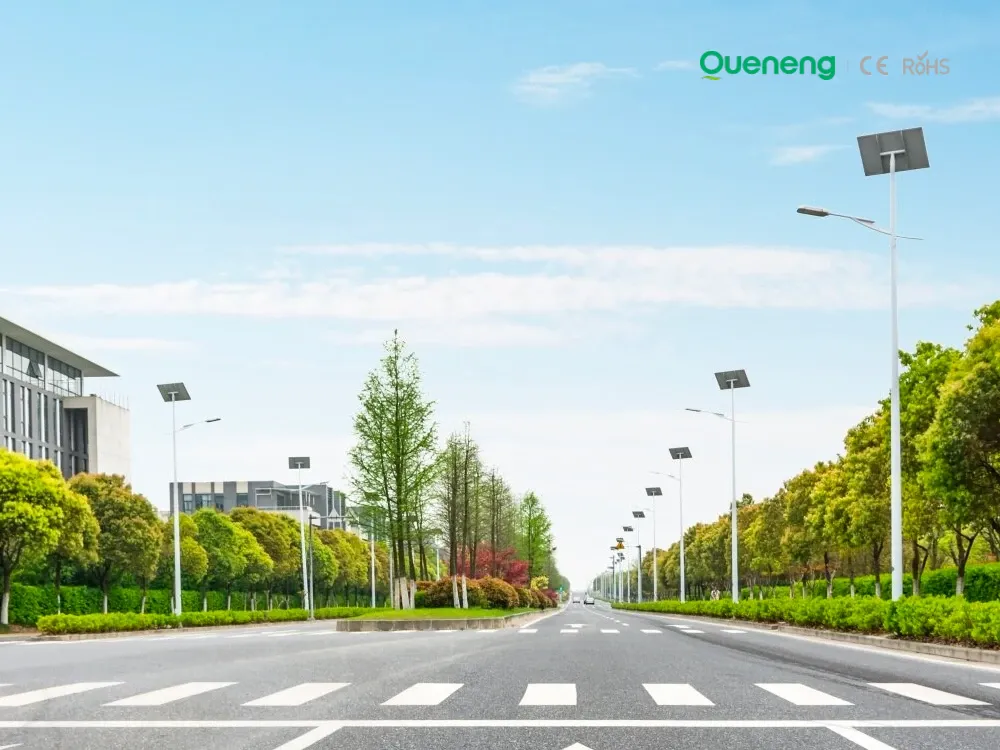
In recent years, the purchase of solar streetlights for municipalities has become a growing trend across the globe. Local governments are under pressure to reduce public expenditure, promote green energy, and create safer communities. Solar streetlights provide a reliable, cost-effective, and sustainable solution that meets these needs. Queneng Lighting, as a leading solar street lighting manufacturer, has supported multiple municipal projects worldwide with customized and energy-efficient solutions.
FAQ
Industry
Does Queneng offer off-grid solar systems?
Yes, we provide off-grid solar lighting systems designed for remote areas or regions without grid coverage, meeting the specific lighting needs in these areas.
Battery and Analysis
What is over-discharge and what effect does it have on battery performance?
Can batteries of different capacities be combined?
Battery Performance and Testing
What is a vibration experiment?
After the battery is discharged to 1.0V at 0.2C, charge it at 0.1C for 16 hours. After leaving it aside for 24 hours, it vibrates according to the following conditions:
Amplitude: 0.8mm
Make the battery vibrate between 10HZ-55HZ, increasing or decreasing at a vibration rate of 1HZ every minute.
The battery voltage change should be within ±0.02V, and the internal resistance change should be within ±5mΩ. (Vibration time is 90min)
The lithium battery vibration experiment method is:
After the battery is discharged to 3.0V at 0.2C, charge it to 4.2V with 1C constant current and constant voltage, with a cut-off current of 10mA. After leaving it aside for 24 hours, it vibrates according to the following conditions:
The vibration experiment was carried out with the vibration frequency from 10 Hz to 60 Hz and then to 10 Hz within 5 minutes as a cycle with an amplitude of 0.06 inches. The battery vibrates in three axes, each axis vibrating for half an hour.
The battery voltage change should be within ±0.02V, and the internal resistance change should be within ±5mΩ.
What is the power output of the battery?
The smaller the internal resistance of the battery, the higher the output power. The internal resistance of the battery should be smaller than the internal resistance of the electrical appliance. Otherwise, the power consumed by the battery itself will be greater than the power consumed by the electrical appliance, which is uneconomical and may damage the battery.
Commercial and Industrial Parks
Can the lighting systems be upgraded in the future?
Yes, our modular designs allow for easy upgrades, such as adding smart features or higher capacity batteries.


Queneng's Luzhou Solar Street Light provides sustainable, energy-efficient outdoor LED lighting. Powered by solar energy, it's a cost-effective and eco-friendly solution for illuminating streets and pathways. A reliable and durable LED solar street light.

Queneng’s Solar Street Lights are designed to provide reliable, energy-efficient lighting for streets, parks, and other outdoor spaces.

The Solar Streetlights of Luhao for Municipalities are designed to deliver reliable, energy-efficient, and cost-effective public lighting solutions. Equipped with advanced LED technology, durable lithium batteries, and high-efficiency solar panels, these streetlights provide consistent illumination for roads, parks, residential areas, and government projects.

The Solar Street Light offers an energy-efficient, eco-friendly solution for illuminating outdoor spaces.

Discover the Lulin High-Performance Solar Street Light by Queneng, a durable and energy-saving outdoor lighting solution. Designed for efficiency and reliability, it harnesses solar power to sustainably illuminate streets and pathways. Optimize your outdoor spaces today with Queneng's innovative solar street lighting technology.
If you would like more information about Queneng solar lighting solutions, please send us a message by filling out the form below. Our professional team will get back to you within 24 hours!
Rest assured that your privacy is important to us, and all information provided will be handled with the utmost confidentiality.
Schedule a Meeting

Book a date and time that is convenient for you and conduct the session in advance.
Have more questions about our products or services?

